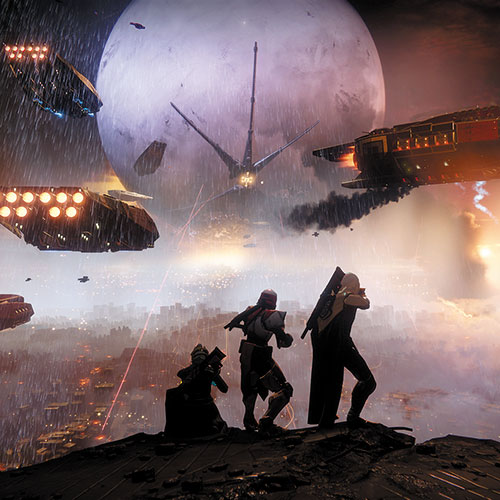Stacked against all odds: ‘Destiny 2’ rebuilds on a firm foundation

By Steve Watts | Shacknews.com (TNS)
Activision’s official promotion for Destiny 2 started with one simple premise: you’d be starting anew. A mad villain had destroyed the Last City, and in the process, taken all of your player progress and hard-earned gear. The message was unmistakable: this was to be a fresh beginning for players, and hopefully, for Bungie itself. Destiny 2 is not a reinvention, for better and for worse. What I’ve played so far felt as comfortable as a well-worn sneaker. Bungie and Activision have chosen to build upon the firm foundation of a very solid first entry in the series, which makes the game feel extremely familiar. The changes that are present are welcome and unsurprising. Take, for example, the raucous applause that followed the announcement that players will be able to hop between planets without going into orbit. This was an obnoxious chore in the first game, and had to be on top of Bungie’s “List of Things We Can’t Get Away With Twice.” It’s an obvious fix, but also, was treated as an applause line. That’s emblematic of a less ambitious sequel than I’d hoped. At the same time, it’s a perfect answer to the players who simply want more Destiny, but better. That’s exactly what this is.
ONCE MORE UNTO THE BREACH
We can already see some of the refined sensibilities showing through in the campaign stage, a short taste of heavily guided story that recreated the stage gameplay demo. Trying it firsthand was a suitably impressive start, carefully treading a tightrope of balance that gave me a sense of empowerment while also letting me get my bearings. Bungie knows this will be the first time playing Destiny for many, and the first time in a long time for many more, so inundating us with hulking brutes who actually aren’t all that tough is a clever way to start. Similarly, the gunplay was as sharp and responsive as ever, with snappy firefights and ability juggling that was easy to get caught up in. The Warlock’s new ability, heavily featured today, is as impressive as the first time you broke out a Supercharged ability in the original. Spurred on by more singular development, Destiny 2 is also a visual treat. Lighting effects and more moving parts at any given time make for a more vibrant, living world than anything done in the first game or its many expansions. Even smaller, quieter moments like the final doomed approach toward the shield generator was given additional ambiance with increased detail on the surrounding piping and smoke rising slowly from the vented corridor just in front of the doorway. All that makes for an experience very similar to what we had played before. I felt right at home, immediately. Other weak spots from the original have purportedly been corrected, with the addition of elements like an improved map structure and more quest types. None of those were on display when I played, though, so I can’t speak to how they might change the experience. I also can’t yet account for how the studio might have approached the progression, which in the first Destiny felt at times too arcane or grindy. Hopefully, it has taken all of those criticisms to heart in equal measure, and issued needed repairs to them as well.
GHOSTS, GUARDIANS, AND MICE
The one marquee feature that really does make Destiny 2 feel different is the addition of a PC version. The lack of one for the first Destiny was downright baffling, given its point-and-click menus and the general temperature of the market. Bringing us one now is another unsurprising addition, but it’s probably the most welcome of any. It’s impressive how immediately the PC version feels right at home with its console counterparts. Even putting aside elements like menu styling, the quick combat-puzzle gameplay style of the game fits cleanly onto a mouse-and-keyboard interface. The gameplay loop, much like Halo before it, is mostly about battlefield management. Dealing with multiple enemies is usually a matter of weakening or staggering one, putting distance or space between yourself and another, and bouncing from target to target. The precision of KB/M control accents this element of Destiny’s core loop nicely.
REFINED MULTIPLAYER
I also had some time in the Crucible, the player-vs-player mode that never much caught my interest in the original. I’m not a convert quite yet, but the changes made this time around are smart and incisive. Going with 4v4 teams across all modes makes for more consistency in both team selection and map design, letting Bungie count on particular types of small-group engagement when planning their corridors. This showed in the one map that I played, a tightly cornered area with lots of structures to provide cover points and ambushes. The new mode Countdown, an attack/defend type, forced confrontations at specific points. More often than not it became akin to Deathmatch, and the rounds were over too quickly to get much of a handle on the objective for the first few rounds. It was a bit disorienting at first, but another in the long list of welcome, simple additions.
GUARDIANS
Sequels are often iterative rather than innovative. Destiny 2 doesn’t appear to be a total sea change from its predecessor, but it has taken criticisms to heart and sanded off some of the rough edges that may have turned off prospective players. It remains to be seen if the progression loop is equally refined, but Bungie has shown a capacity to learn from its mistakes. Destiny 2 is a smarter version of the game we began playing years ago, and that’s exciting even without the element of surprise.
Developer: Bungie
Genre: Action role-playing
Platforms: PlayStation 4, Xbox One, Microsoft Windows
Rating: M for mature











